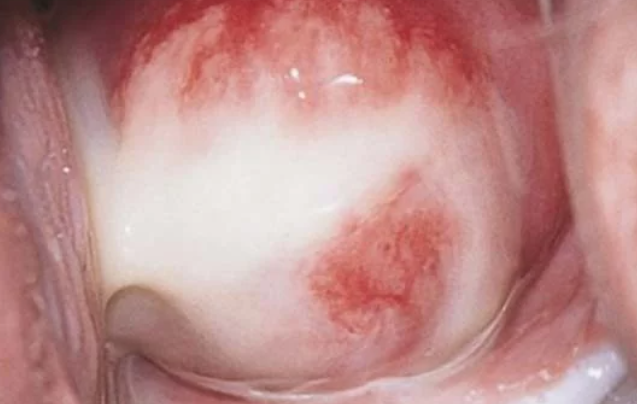Green, yellow, white discharge from woman? Some women do not understand the cause of vaginal discharge and try to get rid of it with personal hygiene.
However, the discharge is a natural juice of the mucous membranes, and like other body fluids (blood, saliva, gastric juice), it has unique functions. Its absence, changes in its character may indicate an abnormal discharge.
It is necessary to distinguish between abnormal and normal secretions. The gynecologist should explain the nature of them to the woman, but the patient is required to be careful with her body and be able to distinguish the norm from the abnorm.
To know which discharge is normal and which is abnormal, it is necessary to know about the most common diseases accompanied by secretions.
[lwptoc]
Causes Of Normal And Abnormal Discharge From The Vagina
First of all, it is easier to talk about normal discharges:
- A clear, mucous discharge may occur before ovulation.
- Excessive secretion of cream or sac is natural for the first half of the menstrual cycle.
- Creamy or acidic secretions, but in small amounts, were characteristic of the second half of the menstrual cycle.
- White or clear, clear discharge may occur for some time after sexual intercourse.
- A small amount of bloody discharge occurs before ovulation.
- Brown discharge – the first week of taking hormonal contraceptives is normal.
- Odorless white discharge during pregnancy, which may increase, may persist throughout pregnancy.
The nature of most normal discharges may change during the menstrual cycle, but there should be no unpleasant odor. This is normal in older women. In some diseases, the nature of the normal flow changes.
Discoloration of the secretion is most often due to the following reasons:
- Pregnancy;
- Menopaus;
- New born;
- Taking certain medications;
- Diseases of the genitals;
- Venereal diseases.
In each of these cases, the color and consistency, odor and other characteristics of the secretion may change.
Green Discharge
Green discharge belongs to the pathological type, because it is a sign of both sexually transmitted diseases and inflammatory processes, resulting from the release of large amounts of leukocytes into the vaginal juice.
The most common causes of green or yellowish-green discharge are:
- Bacterial vaginosis is an infectious-inflammatory process caused by bacteria. It can be caused by an infection from a sexual partner, as well as normal stress or the onset of pregnancy. Itching and itching may occur in the genital area.
- Trichomoniasis – green discharge may be the only sign of this dangerous disease. It is necessary to undergo special tests to confirm it, so a green discharge is a good reason to go to the doctor.
- Candidiasis – sometimes accompanied by greenish or creamy discharge.
- Pregnancy – green discharge may be due to changes in the hormonal background at the very beginning of pregnancy. Although this is a normal physiological process, latent infections can be activated in the background, which requires consultation with a gynecologist.
- Gonorrhea is a very dangerous disease that requires consultation with a gynecologist.
- Inflammatory process – in this case the secretion turns yellowish-green color.
The green color of the secretion is a sign of semi-normal, semi-disease. This colored discharge indicates changes in the female body and requires a serious approach.

Yellow Discharge
Yellow secretion can be considered the norm, if it is small and odorless. Many changes in the body, both normal and pathological, can cause such a secretion. Yellow discharge can be considered normal only in the following cases:
- The amount does not go beyond one teaspoon daily.
- It has no smell.
- The shade is not bright.
- The secretion is clear, clot-free and even in consistency.
In other cases, jaundice may be both a norm and a sign of infection. The main causes of such secretions are:
- New birth. Within 6-8 weeks after birth, a woman may have a yellow discharge, which does not cause any discomfort. This is normal for the menstrual cycle, but because the woman’s body is weakened, there is always a risk of infection. Therefore, if the discharge worries a woman, it is necessary to consult a gynecologist.
- Adnexitis – inflammation of the uterine growths.
- Salpingitis is an inflammation of the fallopian tubes only.
- Vaginitis is an inflammation of the lining of the uterus, which, in addition, is accompanied by pain and itching during sexual intercourse.
- Gonorrhea, chlamydia and trichomoniasis are venereal diseases, often accompanied by a yellowish-green discharge, which indicates an inflammatory process. One of the important symptoms of these diseases is the smell of rotten fish.
Each of these reasons requires a doctor’s examination and appropriate treatment. In case of abnormal yellow discharge, it is necessary to immediately go to the clinic and give tests.
White Discharge

White discharge is normal in all women. Often its amount increases before or after menstruation and during pregnancy.
If the amount of such secretions is not large, and if the consistency is homogeneous and there is no odor – the woman should not worry.
In other cases, white discharge is a sign of sexually transmitted diseases, fungal infections and inflammation. The main causes of white discharge were:
- Vaginitis is an inflammation of the lining of the vagina
- Adnexitis – inflammation of the uterine growths
- Improper choice of personal hygiene products
- Shaking of the uterine wall
- Candidiasis
- Taking hormonal drugs for a long time
- Types of sprinting washing vaginal flora
- A sedentary lifestyle
- Violation of personal hygiene rules.
The amount of white secretion before ovulation may increase, so it is very difficult to link its absence to the disease. If the discharge increases at other times of the cycle or is accompanied by unusual symptoms, a gynecologist should be consulted.
Bloody Discharge
Bloody discharge is the most dangerous and can be a sign of many diseases. Such secretions should attract the woman’s attention when they are in large quantities and are accompanied by other symptoms – pain, itching and nausea. The reasons for this flow are as follows:
- Cervical deterioration;
- Fibromyomas ;
- Endometritis ;
- Sarcomas;
- Cancer;
- Endometriosis;
- Polyps.
Given that almost all of these diseases can pose a serious threat to a woman’s health and life, it is necessary to consult a doctor immediately as soon as there is such a secretion. However, bloody discharge does not always mean a serious illness. In some cases, there may be other minor disorders:
- Polyps, small wounds, warts on the genitals.
- Infection of the genitals.
- Excessive dryness of the vagina can cause bloody discharge after sexual intercourse. This is especially true for women approaching menopause.
- Complications after abortion.
- Taking inappropriate hormonal contraceptives.
- The onset of menopause – during this period, sometimes a small amount of bloody secretions is the norm.
Each of these reasons requires a gynecologist’s examination and analysis to make a diagnosis. Only after the disease or pathology is detected, the doctor can prescribe treatment.
Black Discharge
Black discharge is a type of bloody discharge, which is very dark in color, and the secretion itself is solid and heterogeneous. Such secretions can be both normal and abnormal. Black discharge may be a sign of the following diseases :
- Disorders of metabolism and endocrine system
- A sudden change in weight – both obesity and loss of adipose tissue
- Prolonged inflammatory and infectious processes
- Results of chemotherapy
- Stresses
- Hormonal imbalance caused by various reasons
- Endometriosis
- Endometrial hyperplasia
- Improperly selected contraceptives or their abrupt cessation
- Polyps in the genitals
- Some systemic diseases.
It is necessary to consult a doctor to examine the causes of black discharge. The reasons are very different, so only a specialist can make a specific diagnosis.
Good Flow
Symptoms of genital diseases include not only the color of the secretions, but also the smell and quantity. Normally, vaginal discharge does not smell or is weakly sour. If there is an unpleasant odor, for example, the smell of dead animal (rotten fish) or lactic acid products, it is a sign of venereal or inflammatory diseases.
In most cases, the reasons why discharge smells like dead animal indicates the following diseases or conditions:
- Inflammation caused by microorganisms. In this case, the amount of secretion is very high.
- Metabolic disorders in the body for various reasons.
- Hormonal imbalance in the body for certain reasons.
- The result of long-term antibacterial treatment.
- Violation of intimate hygiene of the genitals.
- Pregnancy.
- Prolonged sprinting resulting in washing of the vaginal flora.
- Oncological diseases of the genital organs.
- Results of chemotherapy.
- Presence of candidiasis.
- Development of bacterial vaginosis.
- Qonoreya.
- Xlamidioz.
- Trixomoniaz.
These are not all diseases that cause odorous vaginal discharge. These are the most common. In any case, the best course of action is to consult a gynecologist in case of foul-smelling secretions. The sooner the causes of these changes are identified, the sooner you can get rid of them.
You May Also Like:
- Is Brown Discharge A Sign Of Pregnancy?
- What Is The Role Of Clear Watery Discharge During Pregnancy?
- Why Do Watery Discharge Before Period Occur?
- 5 Remedies For Each Type Of Vaginal Discharge
- What Does Each Color Of Vaginal Discharge Mean? 5 Types of vaginal discharge
Treatment Of Discharge

The treatment of any discharge depends on several factors – their causes, the type of disease, the period of the menstrual cycle, etc. For proper treatment, a diagnosis is made to investigate the cause of the discharge. These include:
- Cytological analysis;
- Ointment for sexually transmitted infections;
- Blood test depending on the nature of the discharge;
- Planting analysis;
- PCR;
- PH-metry – study of uterine acidity;
- Microscopic examination of the obtained analyzes.
If necessary, the doctor may prescribe other methods of examination, but for most diseases, a few tests are enough.
Treatment is started after the doctor makes an accurate diagnosis, because a group of specific drugs is used for this purpose.
This is one group for venereal diseases, and another for inflammatory processes. Certain diseases may also require additional examination, surgery, or conservative therapy.
Therefore, drugs prescribed by a doctor should not be replaced by analogues without his permission.
Common diseases and their treatment:
- Trichomoniasis – drugs such as ornidazole, metronidazole, nimorazole, tinidazole are prescribed.
- Bacterial vaginosis – Clindamycin, Metronidazole (in gel or tablet form), Ornisid forte is prescribed.
- Candidiasis – antifungal drugs, Clotrimazole (in the form of vaginal tablets or cream), Irunin, Orungal, Isoconazole, Fluconazole, Mycomax, Flucostat are used.
These were the most commonly prescribed drugs with a special profile, which are used in the treatment of venereal and fungal diseases, but the specific drug is prescribed by a doctor after examination and examination. Self-medication is dangerous and ineffective, so always follow the advice of specialists and consult a doctor before taking any medication.
Premenstrual And Postmenstrual Discharge

It is normal to have a lot of clear and odorless secretions in the second half of menstruation and before menstruation, because the body reacts to the approach of menstruation. Also, the presence of a small amount of brown secretion two days before menstruation is not a sign of pathology. However, if there are still more than two days left before menstruation, such secretions may indicate some diseases of the genitals.
The same applies to postmenstrual discharge. Brown discharge lasting more than two days also indicates the following pathologies:
- Chronic inflammatory diseases of the vagina or growths, endometriosis;
- Venereal diseases;
- Various dysfunctions of the reproductive system;
- Deterioration of the cervix – if the discharge is before menstruation.
Premenstrual secretion can also occur in systemic connective tissue diseases, which can manifest itself not only in changes in the genitals, but also in other systems. These may include hematological disorders and adenomyosis.
If such a secretion repeatedly bothers a woman and other symptoms – pain, itching, nausea in the external genitalia, changes in the smell and amount of discharge during the menstrual cycle – it is necessary to consult a doctor to examine and prescribe appropriate treatment.
Discharge During Sexual Intercourse
The nature of the discharge changes during and immediately after sexual intercourse, which often causes discomfort to the woman.
Normally, the secretion may be solid, increasing during and after sexual intercourse. If the discharge turns white and does not smell – this is the norm, because it looks like an old, processed oily secretion.
Its presence in the female body is not only natural, but also necessary. The absence of such secretions indicates dryness of the uterine wall, which is considered a pathology.
But sometimes during and after sexual intercourse there is a dark or bloody discharge, which can be a sign of some diseases and disorders:
- Mechanical damage to the uterus – can be observed after very intense sexual intercourse, excessive discharge, accompanied by pain in the vagina.
- Venereal diseases – in chlamydia, such discharge often occurs after sexual intercourse, because the microorganisms damage the mucous membrane and make it susceptible to external influences.
- Inflammatory process in the genitals.
- Polyp of the cervical canal.
- Cervical cancer – bloody discharge during sexual intercourse is often the only sign of the disease, so as soon as you see such a discharge, you need to see a doctor immediately.
If such a discharge is disturbing and accompanied by other symptoms, the woman should consult a gynecologist to investigate the cause of the problem.
Discharge In Girls
Normal discharge in women indicates the presence of an inflammatory process or vulvovaginitis in girls. The disease is rare in adults, because uterine secretions are very acidic for the cocci flora, but in girls it is possible because the natural defense system is not yet fully developed.
Strong secretion in girls before puberty can be due to the following reasons:
- Bacterial vulvovaginitis – its symptoms include hyperemia of the external genitalia, pus and purulent discharge.
- Enterobiasis – a worm infestation in the external genitalia.
- Exudative diathesis – this disease often causes dryness and hyperemia of the genitals.
- Candidiasis is a fungal infection that occurs as a result of stress and dysfunction of the immune system.
- Uterine foreign bodies – found in childhood. Babies can unknowingly injure themselves – a foreign body sticks in their nose and ears – all parents know this, but they can also do it with their genitals.
- Trichomoniasis – the presence of green discharge indicates this disease. It is sometimes transmitted through the home, but is almost always transmitted to the newborn.
- Infection with chlamydia, herpes or mycoplasmosis – during intrauterine development, at birth and later – can be transmitted from adults to adults.
- Allergic reaction to hygiene products or underwear.
Regardless of the cause, it is necessary to consult a doctor as soon as a girl develops a discharge, because it is always a sign of infection.
Premenstrual And Postpartum Discharge

Pregnancy changes many things in a woman’s body, so the cause of any secretion can be discussed only after a gynecologist’s examination. But there are a number of known causes of prenatal discharge:
- At 37-38 weeks, as well as immediately after the gynecologist’s examination, brown discharge is normal, because during this period the fetus is already mature and the uterus is preparing for birth.
- A large amount of mucous secretion indicates the emergence of a blockage. Sometimes there may be traces of blood in the secretion, but if the woman does not feel discomfort at this time, it is considered normal.
- The presence of candidiasis – a secretory layer, white in color and with a creamy consistency. It is necessary to be examined by a doctor before birth and to start treatment on time, because the time of delivery can pass to the offender.
- Coupling is diagnosed in the near term and can be very dangerous if not treated in time. In case of excessive bloody discharge, it is necessary to consult a doctor immediately.
- Clear transparent discharge is a sign of amniotic fluid leakage, which can be dangerous before birth and requires medical attention.
- Fetal hypoxia – green or yellow secretion. This type of discharge can also occur with some venereal diseases, so it is necessary to check with a gynecologist.
Most of these causes are quickly eliminated when a woman sees a doctor. Therefore, abnormal discharge during pregnancy and before birth is a good reason to see a doctor.
Discharge After Abortion
After a medical abortion, there may be both dark and bloody discharge, which is due to the effect of the drug used, which causes an artificial opening. However, discharge after a surgical abortion can be a sign of infection or residue. The causes of post-abortion discharge are:
- Normal blood clotting – brown discharge within 10 days after abortion.
- Polyps – light brown discharge, accompanied by pain during sex.
- Endometriosis is a disease that often occurs as a complication of abortion.
- Endometritis – pain that occurs when the menstrual cycle is restored is considered normal if it does not cause discomfort, otherwise it requires a gynecological examination, as endometritis can later turn into endometriosis.
- Bacterial infections of various origins – their sign is green, and sometimes – yellowish discharge.
- Venereal diseases – chlamydia, trichomoniasis and other sexually transmitted diseases can increase the amount of yellow or green discharge after abortion.
All this requires a doctor’s examination and appropriate treatment. Therefore, in case of abnormal discharge after abortion, it is necessary to consult a specialist to confirm the diagnosis.
This article is an intellectual property of myhealthmyskin.com.ng
If you want to read more articles similar to normal and abnormal discharge in women and girls? We recommend you visit our Women’s Health category.

Have You Ever Had Any Abnormal Vaginal Discharge? Have You Discussed This Event With Your Gynecologist? Comment Below!







